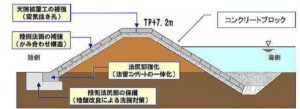[理工学部、建築・環境学部教養学会ミニ講演会]
(第63回理科系学生のための公開英語講演会)
Lessons Learned from the 2011 Tohoku Earthquake and Tsunamis
2011年東北地方太平洋沖地震津波から学んだ教訓
講師:理工学部理工学科、土木・都市防災コース
福谷 陽
2024年1月1日に石川県能登地方を震源として津波を伴う大規模な地震が発生しました。
お亡くなりになられた方々に謹んでお悔みを申し上げます。
また、被災されておられる方々に心よりお見舞いを申し上げます。
As the research in seismic engineering has revealed the causes of earthquakes, so we have come to understand how tsunamis are created as their consequences: a tsunami is created in most cases when a substantial amount of seawater is displaced due to the crustal deformation of the earth.
Though we are more or less familiar with the generation mechanism of tsunamis, however, we do not seem to know precisely how high the oncoming tsunamis could be, or which part of our town will possibly be inundated with tidal waves.
In fact, even scientists could not predict the degree of the damage caused to the coastal areas of Northeast region of Japan by the Great East Japan Earthquake, as evidenced by the fact that the areas inundated by the tsunamis on that disaster widely exceeded the areas specified in the hazard map published before the disaster.
If the hazard map prepared before the disaster had not been instructive enough to have people evacuate safely, what kind of hazard map could help us escape from possible future disasters?
In December 18, hoping to find some answers to the above question and other questions related to it, we invited Dr. Fukutani of Civil Engineering Course as a lecturer for the 63rd session of the Lecture Meetings for Science Major Students.
This session was the 4th opportunity on which the lecturer gave a talk with the same title to the audience consisting mainly of science major students.
Dr. Fukutani, an expert in the field of prevention of damage caused by natural disasters, especially the damage caused by tidal waves, has energetically conducted on-site research into what exactly happened in that disaster.
In this lecture, Dr. Fukutani talked about two major topics: (i) creation of earthquakes and the mechanism in which the tidal waves are formed in the wake of earthquakes, and (ii) how the disaster was caused in the Great East Japan Earthquake in 2011 and its effects afterwards. This lecture was a valuable opportunity for us to deepen our understanding of the lessons we learned from the unprecedented catastrophe.
The following are some of the questions raised and answers given in the final portion of this program:
Questions and Answers
Q. From my materials I learned about some examples of structural measures such as tsunami walls. My question is “What are possible tsunami protection measures for house construction?
私は資料で津波防壁のような構造的な対策の例を学びました。住宅建設における津波対策は何ですか?
A. When a tsunami runs up, it has very strong wave force. Therefore, buildings exposed to tsunami risk may take measures to dissipate the force of tsunami waves by arranging many openings or making the first floor piloti-style. Although this is rarely the case for ordinary houses, these measures are considered especially when constructing tsunami evacuation buildings.
Q. What are the characteristics of a seawall that has a structure that is resilient to tsunamis?
津波に対して粘り強い構造の防潮堤にはどのような特徴がありますか。
A. The figure below shows an example of a tenacious structure of a seawall. There are two main characteristics: first, it is trapezoidal in shape so that it is not easily overturned by wave forces; second, the top edge of the seawall, the landward slope, and the bottom of the slope are reinforced with concrete or other materials. This is based on lessons learned from the Great East Japan Earthquake.
出典:東北地方整備局 仙台河川国道事務所 宮城県土木部

